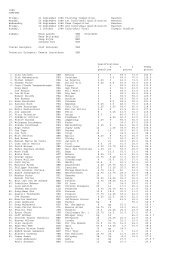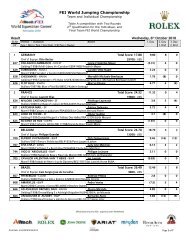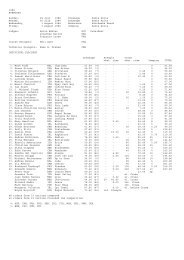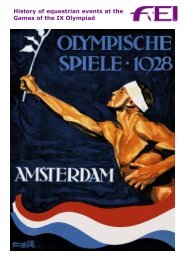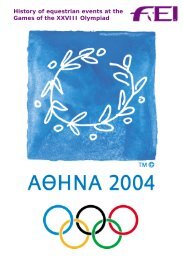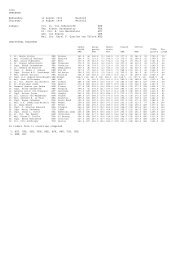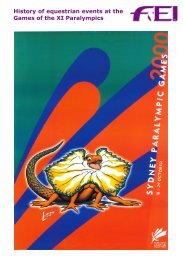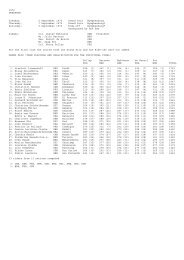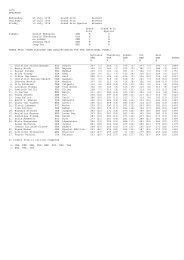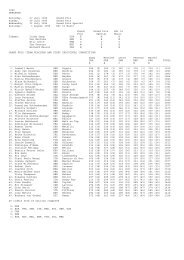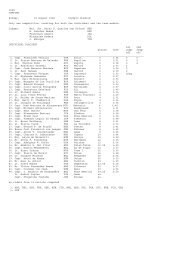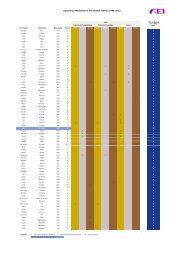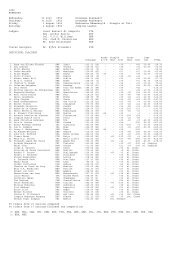History of equestrian events at the Games of the V ... - FEI History Hub
History of equestrian events at the Games of the V ... - FEI History Hub
History of equestrian events at the Games of the V ... - FEI History Hub
Create successful ePaper yourself
Turn your PDF publications into a flip-book with our unique Google optimized e-Paper software.
<strong>History</strong> <strong>of</strong> <strong>equestrian</strong> <strong>events</strong> <strong>at</strong> <strong>the</strong> 1912<br />
Olympic <strong>Games</strong> in Stockholm, Sweden<br />
EVENTING (27 riders from seven n<strong>at</strong>ions)<br />
Only 10 years after a Championn<strong>at</strong> du Cheval d’Armes was held for <strong>the</strong> first time in France,<br />
<strong>the</strong> Olympic “Military” was organised in Stockholm. Only teams <strong>of</strong> three or four riders were<br />
allowed and <strong>the</strong>y had to be <strong>of</strong>ficers on <strong>the</strong>ir own horses belonging to <strong>the</strong>ir army. The<br />
competition was held over five days (with one rest day), as follow:<br />
1 st day: A: Endurance ride over 55km in 4 hours<br />
Including:<br />
B:Cross-country over 5 km in 15 minutes (12 obstacles)<br />
3 rd day: C: Steeplechase over 3500m. in 5 minutes and 50 seconds (10 obstacles)<br />
4 th day: D: Jumping over 15 obstacles, up to 1.30m high and 3.00m wide<br />
5 th day: E: Dressage<br />
In each <strong>of</strong> <strong>the</strong> five phases a maximum <strong>of</strong> 10 points could be won.<br />
Sweden took <strong>the</strong> team gold medal ahead <strong>of</strong> Germany and <strong>the</strong> United St<strong>at</strong>es. Member <strong>of</strong> <strong>the</strong><br />
l<strong>at</strong>ter was Capt. Guy Henry on Chiswell. In <strong>the</strong> early thirties General Henry was chief <strong>of</strong> <strong>the</strong><br />
US Cavalry and, during <strong>the</strong> 1932 Olympic <strong>Games</strong>, president <strong>of</strong> <strong>the</strong> <strong>FEI</strong>.<br />
Medallists – Individual<br />
1. Gold Axel Nordlander (SWE) Lady Artist<br />
2. Silver Harry von Rochow (GER) Idealist<br />
3. Bronze Jean Cariou (FRA) Cocotte<br />
Medallists – Team<br />
1. Gold Sweden<br />
2. Silver Germany<br />
3. Bronze USA<br />
Axel NORDLANDER (Lady Artist),<br />
Nils ADLERCREUTZ (Atout),<br />
Ernst CASPARSSON (Irmelin),<br />
Henric HORN AF AMINNE (Omen)<br />
Harry VON ROCHOW (Idealist),<br />
Eduard VON LUTCKEN (Blue Boy),<br />
Richard VON SCHAESBERG (Grundsee),<br />
Carl VON MOERS (May Queen)<br />
Benjamin LEAR (Poppy),<br />
John C. MONTGOMERY (Deceive),<br />
Guy V. HENRY (Chiswell),<br />
Ephraim F. GRAHAM (Connie)<br />
World War I prevented <strong>the</strong> organis<strong>at</strong>ion <strong>of</strong> <strong>the</strong> 1916 Olympic <strong>Games</strong>. When <strong>at</strong> short notice<br />
in 1919, Antwerp, Belgium, accepted to stage <strong>the</strong> <strong>Games</strong> <strong>of</strong> <strong>the</strong> VII Olympiad in 1920, <strong>the</strong><br />
1912 programme, with some altern<strong>at</strong>ions, was used.<br />
5



